济慈《秋颂》原文阅读
- 格式:doc
- 大小:24.50 KB
- 文档页数:2
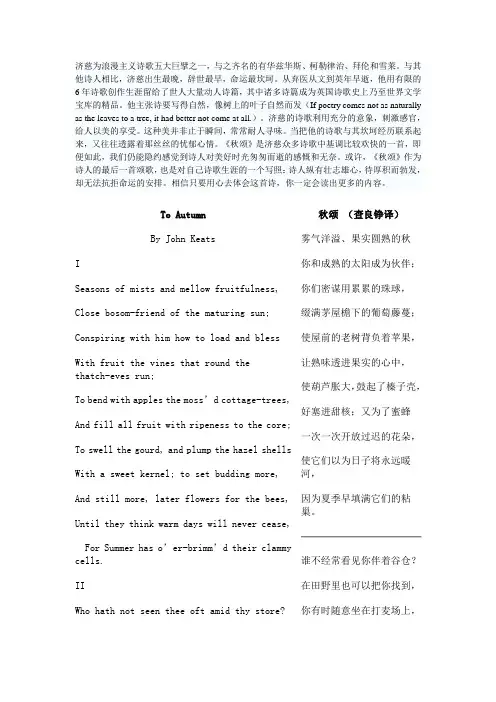
济慈为浪漫主义诗歌五大巨擘之一,与之齐名的有华兹华斯、柯勒律治、拜伦和雪莱。
与其他诗人相比,济慈出生最晚,辞世最早,命运最坎坷。
从弃医从文到英年早逝,他用有限的6年诗歌创作生涯留给了世人大量动人诗篇,其中诸多诗篇成为英国诗歌史上乃至世界文学宝库的精品。
他主张诗要写得自然,像树上的叶子自然而发(If poetry comes not as naturally as the leaves to a tree, it had better not come at all.)。
济慈的诗歌利用充分的意象,刺激感官,给人以美的享受。
这种美并非止于瞬间,常常耐人寻味。
当把他的诗歌与其坎坷经历联系起来,又往往透露着那丝丝的忧郁心情。
《秋颂》是济慈众多诗歌中基调比较欢快的一首,即便如此,我们仍能隐约感觉到诗人对美好时光匆匆而逝的感慨和无奈。
或许,《秋颂》作为诗人的最后一首颂歌,也是对自己诗歌生涯的一个写照:诗人纵有壮志雄心,待厚积而勃发,却无法抗拒命运的安排。
相信只要用心去体会这首诗,你一定会读出更多的内容。
To AutumnBy John KeatsISeasons of mists and mellow fruitfulness, Close bosom-friend of the maturing sun; Conspiring with him how to load and blessWith fruit the vines that round the thatch-eves run;To bend with apples the moss’d cottage-trees, And fill all fruit with ripeness to the core; To swell the gourd, and plump the hazel shells With a sweet kernel; to set budding more, And still more, later flowers for the bees, Until they think warm days will never cease,For Summer has o’er-brimm’d their clammy cells.IIWho hath not seen thee oft amid thy store?秋颂(查良铮译)雾气洋溢、果实圆熟的秋你和成熟的太阳成为伙伴;你们密谋用累累的珠球,缀满茅屋檐下的葡萄藤蔓;使屋前的老树背负着苹果,让熟味透进果实的心中,使葫芦胀大,鼓起了榛子壳,好塞进甜核;又为了蜜蜂一次一次开放过迟的花朵,使它们以为日子将永远暖河,因为夏季早填满它们的粘巢。
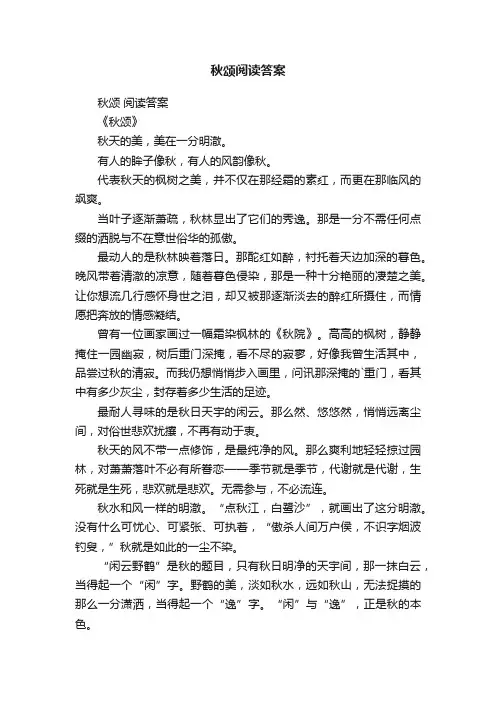
秋颂阅读答案秋颂阅读答案《秋颂》秋天的美,美在一分明澈。
有人的眸子像秋,有人的风韵像秋。
代表秋天的枫树之美,并不仅在那经霜的素红,而更在那临风的飒爽。
当叶子逐渐萧疏,秋林显出了它们的秀逸。
那是一分不需任何点缀的洒脱与不在意世俗华的孤傲。
最动人的是秋林映着落日。
那酡红如醉,衬托着天边加深的暮色。
晚风带着清澈的凉意,随着暮色侵染,那是一种十分艳丽的凄楚之美。
让你想流几行感怀身世之泪,却又被那逐渐淡去的醉红所摄住,而情愿把奔放的情感凝结。
曾有一位画家画过一幅霜染枫林的《秋院》。
高高的枫树,静静掩住一园幽寂,树后重门深掩,看不尽的寂寥,好像我曾生活其中,品尝过秋的清寂。
而我仍想悄悄步入画里,问讯那深掩的`重门,看其中有多少灰尘,封存着多少生活的足迹。
最耐人寻味的是秋日天宇的闲云。
那么然、悠悠然,悄悄远离尘间,对俗世悲欢扰攘,不再有动于衷。
秋天的风不带一点修饰,是最纯净的风。
那么爽利地轻轻掠过园林,对萧萧落叶不必有所眷恋——季节就是季节,代谢就是代谢,生死就是生死,悲欢就是悲欢。
无需参与,不必流连。
秋水和风一样的明澈。
“点秋江,白鹭沙”,就画出了这分明澈。
没有什么可忧心、可紧张、可执着,“傲杀人间万户侯,不识字烟波钓叟,”秋就是如此的一尘不染。
“闲云野鹤”是秋的题目,只有秋日明净的天宇间,那一抹白云,当得起一个“闲”字。
野鹤的美,淡如秋水,远如秋山,无法捉摸的那么一分潇洒,当得起一个“逸”字。
“闲”与“逸”,正是秋的本色。
也有某些人,具有秋的美。
也必须是这样的人,才会有这样的美。
这样的美来自内在,他拥有一切,却并不想拥有任何。
那是由极深的认知与感悟所形成的一种透彻与洒脱。
秋是成熟的季节,是收获的季节,是充实的季节,却也是淡泊的季节。
它饱经了春的蓬勃与夏之盛,不再以受赞美、被宠爱为荣。
它把一切赞美与宠爱都隔离在的秋光之外,而只愿做一个闲闲的、远远的,可望而不可即的——秋。
1,作者在写到秋风卷落叶时,说到“季节就是季节,代谢就是代谢,生死就是生死,悲欢就是悲欢,从中我们体会到作者这样的胸怀?对你做人有什么启示?2,可不可以把第2段改为”秋像某些人的眸子,秋像某些人的风韵“?,试从内容和结构角度谈谈你的理解。

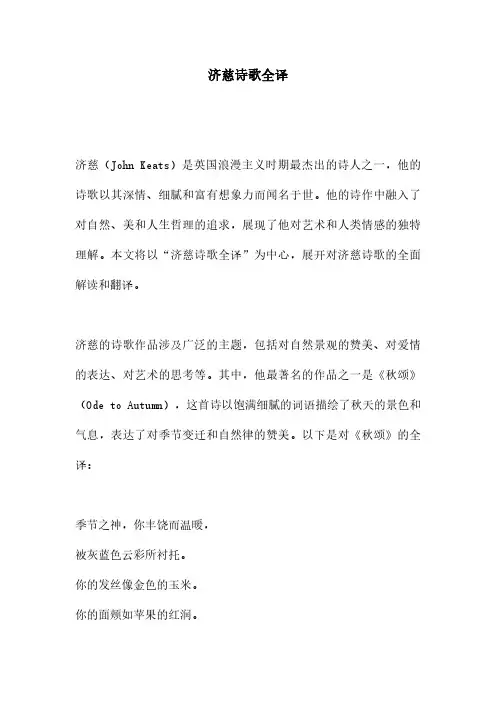
济慈诗歌全译济慈(John Keats)是英国浪漫主义时期最杰出的诗人之一,他的诗歌以其深情、细腻和富有想象力而闻名于世。
他的诗作中融入了对自然、美和人生哲理的追求,展现了他对艺术和人类情感的独特理解。
本文将以“济慈诗歌全译”为中心,展开对济慈诗歌的全面解读和翻译。
济慈的诗歌作品涉及广泛的主题,包括对自然景观的赞美、对爱情的表达、对艺术的思考等。
其中,他最著名的作品之一是《秋颂》(Ode to Autumn),这首诗以饱满细腻的词语描绘了秋天的景色和气息,表达了对季节变迁和自然律的赞美。
以下是对《秋颂》的全译:季节之神,你丰饶而温暖,被灰蓝色云彩所衬托。
你的发丝像金色的玉米。
你的面颊如苹果的红润。
你的伴侣是草原和果实,他们跟随你的脚步,把温暖的阳光洒向大地。
琥珀色的麦田静静摇曳,金色的果实垂挂在树枝上。
葡萄酒榨汁的声音回响,蜂蝶忙碌在鲜花之间。
红色的蜜蜂嗡嗡作响,收割者的歌声乐此不疲。
你是繁荣的季节,你把丰收的喜悦带给人们。
你的阳光如黄金一般温暖,你的微风轻拂着脸庞。
你是大地的恩赐,你是生命的源泉。
《秋颂》展现了济慈对秋天的独特感悟,他通过细腻的描写和丰富的意象,描绘出秋天的丰饶和生机。
在他的笔下,秋天不再是凋谢和死亡的象征,而是一季丰收和生命的盛宴。
除了《秋颂》,济慈还有许多其他优秀的诗作。
他的诗集《夜想集》(Nocturnes)中包含了一系列对夜晚景色的描写,表达了他对夜晚的独特情感和思考。
以下是对《夜想集》中的一首诗的全译:月光洒在静谧的大地上,星星点缀着黑色的天空。
夜晚如黑色的绸缎般沉静,它抚平了白天的纷扰。
夜的湖泊闪烁着银色的光,树林中的影子在风中摇曳。
夜莺在枝头高声歌唱,它们的歌声如水晶般清澈。
我独自站在这片黑暗中,感受着宇宙的神秘魅力。
我沉浸在夜晚的静谧中,让思绪在黑暗中自由飞翔。
济慈的诗歌充满了对自然、美和人生的思考和感悟,他用细腻的笔触和丰富的意象,展现了他对世界的敏感和独特的艺术眼光。
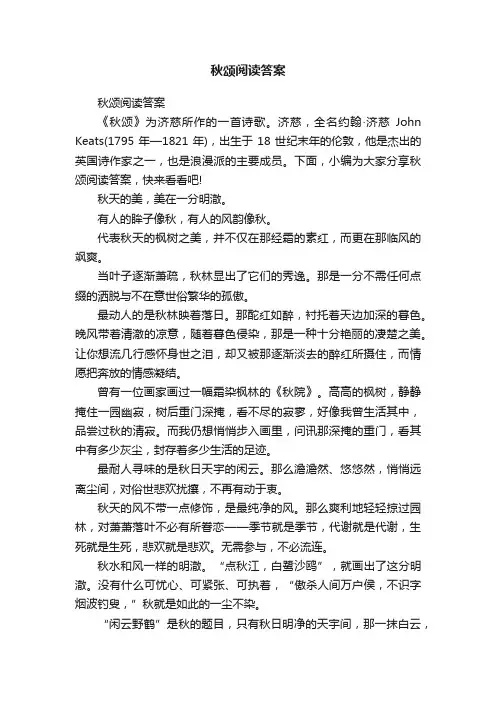
秋颂阅读答案秋颂阅读答案《秋颂》为济慈所作的一首诗歌。
济慈,全名约翰·济慈John Keats(1795年—1821年),出生于18世纪末年的伦敦,他是杰出的英国诗作家之一,也是浪漫派的主要成员。
下面,小编为大家分享秋颂阅读答案,快来看看吧!秋天的美,美在一分明澈。
有人的眸子像秋,有人的风韵像秋。
代表秋天的枫树之美,并不仅在那经霜的素红,而更在那临风的飒爽。
当叶子逐渐萧疏,秋林显出了它们的秀逸。
那是一分不需任何点缀的洒脱与不在意世俗繁华的孤傲。
最动人的是秋林映着落日。
那酡红如醉,衬托着天边加深的暮色。
晚风带着清澈的凉意,随着暮色侵染,那是一种十分艳丽的凄楚之美。
让你想流几行感怀身世之泪,却又被那逐渐淡去的醉红所摄住,而情愿把奔放的情感凝结。
曾有一位画家画过一幅霜染枫林的《秋院》。
高高的枫树,静静掩住一园幽寂,树后重门深掩,看不尽的寂寥,好像我曾生活其中,品尝过秋的清寂。
而我仍想悄悄步入画里,问讯那深掩的重门,看其中有多少灰尘,封存着多少生活的足迹。
最耐人寻味的是秋日天宇的闲云。
那么澹澹然、悠悠然,悄悄远离尘间,对俗世悲欢扰攘,不再有动于衷。
秋天的风不带一点修饰,是最纯净的风。
那么爽利地轻轻掠过园林,对萧萧落叶不必有所眷恋——季节就是季节,代谢就是代谢,生死就是生死,悲欢就是悲欢。
无需参与,不必流连。
秋水和风一样的明澈。
“点秋江,白鹭沙鸥”,就画出了这分明澈。
没有什么可忧心、可紧张、可执着,“傲杀人间万户侯,不识字烟波钓叟,”秋就是如此的一尘不染。
“闲云野鹤”是秋的题目,只有秋日明净的天宇间,那一抹白云,当得起一个“闲”字。
野鹤的美,淡如秋水,远如秋山,无法捉摸的那么一分潇洒,当得起一个“逸”字。
“闲”与“逸”,正是秋的本色。
也有某些人,具有秋的美。
也必须是这样的人,才会有这样的美。
这样的美来自内在,他拥有一切,却并不想拥有任何。
那是由极深的认知与感悟所形成的一种透彻与洒脱。
秋是成熟的季节,是收获的季节,是充实的季节,却也是淡泊的季节。
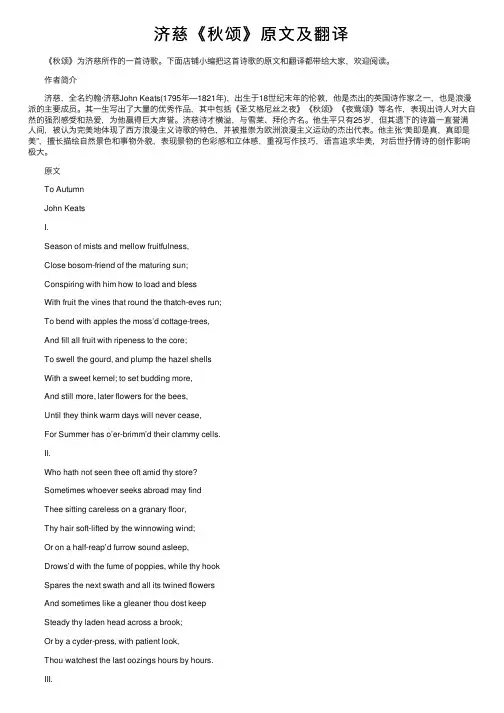
济慈《秋颂》原⽂及翻译 《秋颂》为济慈所作的⼀⾸诗歌。
下⾯店铺⼩编把这⾸诗歌的原⽂和翻译都带给⼤家,欢迎阅读。
作者简介 济慈,全名约翰·济慈John Keats(1795年—1821年),出⽣于18世纪末年的伦敦,他是杰出的英国诗作家之⼀,也是浪漫派的主要成员。
其⼀⽣写出了⼤量的优秀作品,其中包括《圣艾格尼丝之夜》《秋颂》《夜莺颂》等名作,表现出诗⼈对⼤⾃然的强烈感受和热爱,为他赢得巨⼤声誉。
济慈诗才横溢,与雪莱、拜伦齐名。
他⽣平只有25岁,但其遗下的诗篇⼀直誉满⼈间,被认为完美地体现了西⽅浪漫主义诗歌的特⾊,并被推崇为欧洲浪漫主义运动的杰出代表。
他主张“美即是真,真即是美”,擅长描绘⾃然景⾊和事物外貌,表现景物的⾊彩感和⽴体感,重视写作技巧,语⾔追求华美,对后世抒情诗的创作影响极⼤。
原⽂ To Autumn John Keats I. Season of mists and mellow fruitfulness, Close bosom-friend of the maturing sun; Conspiring with him how to load and bless With fruit the vines that round the thatch-eves run; To bend with apples the moss’d cottage-trees, And fill all fruit with ripeness to the core; To swell the gourd, and plump the hazel shells With a sweet kernel; to set budding more, And still more, later flowers for the bees, Until they think warm days will never cease, For Summer has o’er-brimm’d their clammy cells. II. Who hath not seen thee oft amid thy store? Sometimes whoever seeks abroad may find Thee sitting careless on a granary floor, Thy hair soft-lifted by the winnowing wind; Or on a half-reap’d furrow sound asleep, Drows’d with the fume of poppies, while thy hook Spares the next swath and all its twined flowers And sometimes like a gleaner thou dost keep Steady thy laden head across a brook; Or by a cyder-press, with patient look, Thou watchest the last oozings hours by hours. III. Where are the songs of Spring? Ay, where are they? Think not of them, thou hast thy music too, While barred clouds bloom the soft-dying day, And touch the stubble plains with rosy hue; Then in a wailful choir the small gnats mourn Among the river sallows, borne aloft Or sinking as the light wind lives or dies; And full-grown lambs loud bleat from hilly bourn; Hedge-crickets sing; and now with treble soft The red-breast whistles from a garden-croft; And gathering swallows twitter in the skies. 译⽂ 1 雾⽓洋溢,果实圆熟的秋, 你和成熟的太阳成为友伴; 你们密谋⽤累累的珠球, 缀满茅檐下的葡萄藤蔓; 使屋前的⽼树背负着苹果, 让熟味透进果实的⼼中, 使葫芦胀⼤,⿎起了榛⼦壳, 好塞进甜核;⼜为了蜜蜂 ⼀次⼀次开放过迟的花朵, 使它们以为⽇⼦将永远暖和, 因为夏季早填满它们黏巢。
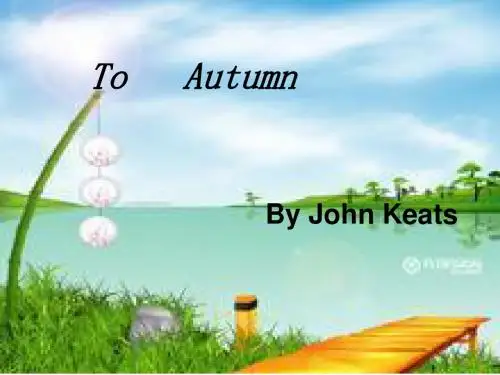
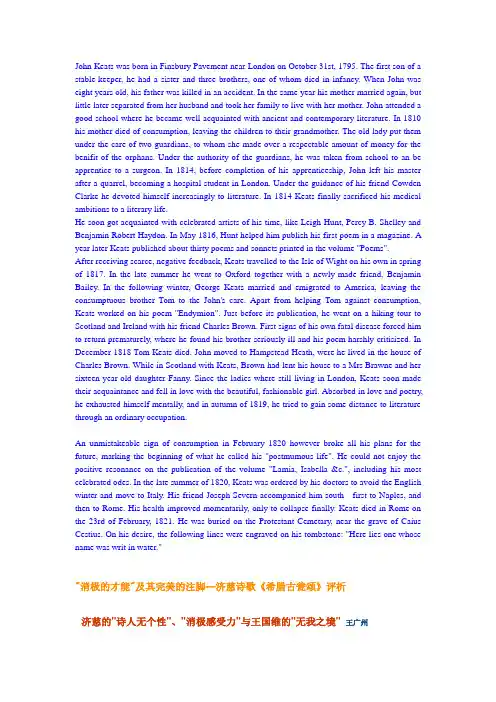
John Keats was born in Finsbury Pavement near London on October 31st, 1795. The first son of a stable-keeper, he had a sister and three brothers, one of whom died in infancy. When John was eight years old, his father was killed in an accident. In the same year his mother married again, but little later separated from her husband and took her family to live with her mother. John attended a good school where he became well acquainted with ancient and contemporary literature. In 1810 his mother died of consumption, leaving the children to their grandmother. The old lady put them under the care of two guardians, to whom she made over a respectable amount of money for the benifit of the orphans. Under the authority of the guardians, he was taken from school to an be apprentice to a surgeon. In 1814, before completion of his apprenticeship, John left his master after a quarrel, becoming a hospital student in London. Under the guidance of his friend Cowden Clarke he devoted himself increasingly to literature. In 1814 Keats finally sacrificed his medical ambitions to a literary life.He soon got acquainted with celebrated artists of his time, like Leigh Hunt, Percy B. Shelley and Benjamin Robert Haydon. In May 1816, Hunt helped him publish his first poem in a magazine. A year later Keats published about thirty poems and sonnets printed in the volume "Poems".After receiving scarce, negative feedback, Keats travelled to the Isle of Wight on his own in spring of 1817. In the late summer he went to Oxford together with a newly-made friend, Benjamin Bailey. In the following winter, George Keats married and emigrated to America, leaving the consumptuous brother Tom to the John's care. Apart from helping Tom against consumption, Keats worked on his poem "Endymion". Just before its publication, he went on a hiking tour to Scotland and Ireland with his friend Charles Brown. First signs of his own fatal disease forced him to return prematurely, where he found his brother seriously ill and his poem harshly critisized. In December 1818 Tom Keats died. John moved to Hampstead Heath, were he lived in the house of Charles Brown. While in Scotland with Keats, Brown had lent his house to a Mrs Brawne and her sixteen-year-old daughter Fanny. Since the ladies where still living in London, Keats soon made their acquaintance and fell in love with the beautiful, fashionable girl. Absorbed in love and poetry, he exhausted himself mentally, and in autumn of 1819, he tried to gain some distance to literature through an ordinary occupation.An unmistakeable sign of consumption in February 1820 however broke all his plans for the future, marking the beginning of what he called his "postmumous life". He could not enjoy the positive resonance on the publication of the volume "Lamia, Isabella &c.", including his most celebrated odes. In the late summer of 1820, Keats was ordered by his doctors to avoid the English winter and move to Italy. His friend Joseph Severn accompanied him south - first to Naples, and then to Rome. His health improved momentarily, only to collapse finally. Keats died in Rome on the 23rd of February, 1821. He was buried on the Protestant Cemetary, near the grave of Caius Cestius. On his desire, the following lines were engraved on his tombstone: "Here lies one whose name was writ in water.""消极的才能"及其完美的注脚--济慈诗歌《希腊古瓮颂》评析济慈的"诗人无个性"、"消极感受力"与王国维的"无我之境" 王广州《希腊古瓮颂》中的"美"与"真"济慈:为世界换一个新的心脏文/张祈2005年09月15日,星期四济慈:为世界换一个新的心脏张祈1世界上的诗人有着种种类型,但有一类诗人最惹人喜爱。
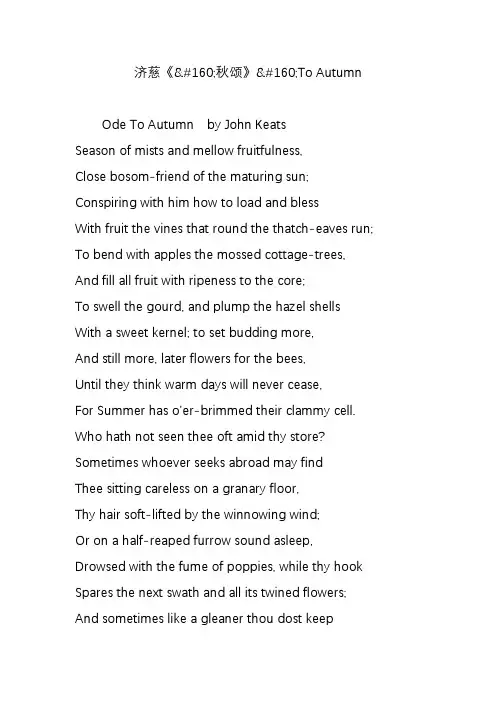
济慈《 秋颂》 To AutumnOde To Autumn by John KeatsSeason of mists and mellow fruitfulness,Close bosom-friend of the maturing sun; Conspiring with him how to load and blessWith fruit the vines that round the thatch-eaves run; To bend with apples the mossed cottage-trees, And fill all fruit with ripeness to the core;To swell the gourd, and plump the hazel shellsWith a sweet kernel; to set budding more,And still more, later flowers for the bees,Until they think warm days will never cease,For Summer has o'er-brimmed their clammy cell. Who hath not seen thee oft amid thy store? Sometimes whoever seeks abroad may findThee sitting careless on a granary floor,Thy hair soft-lifted by the winnowing wind;Or on a half-reaped furrow sound asleep, Drowsed with the fume of poppies, while thy hook Spares the next swath and all its twined flowers; And sometimes like a gleaner thou dost keepSteady thy laden head across a brook;Or by a cider-press, with patient look,Thou watchest the last oozings, hours by hours.Where are the songs of Spring? Ay, where are they? Think not of them, thou hast thy music too,--While barred clouds bloom the soft-dying day,And touch the stubble-plains with rosy hue;Then in a wailful choir, the small gnats mournAmong the river sallows, borne aloftOr sinking as the light wind lives or dies;And full-grown lambs loud bleat from hilly bourn;Hedge-crickets sing; and now with treble softThe redbreast whistles from a garden-croft,And gathering swallows twitter in the skies.雾气洋溢、果实圆熟的秋,你和成熟的太阳成为友伴;你们密谋用累累的珠球,缀满茅屋檐下的葡萄藤蔓;使屋前的老树背负着苹果,让熟味透进果实的心中,使葫芦胀大,鼓起了榛子壳,好塞进甜核;又为了蜜蜂一次一次开放过迟的花朵,使它们以为日子将永远暖和,因为夏季早填满它们的粘巢。
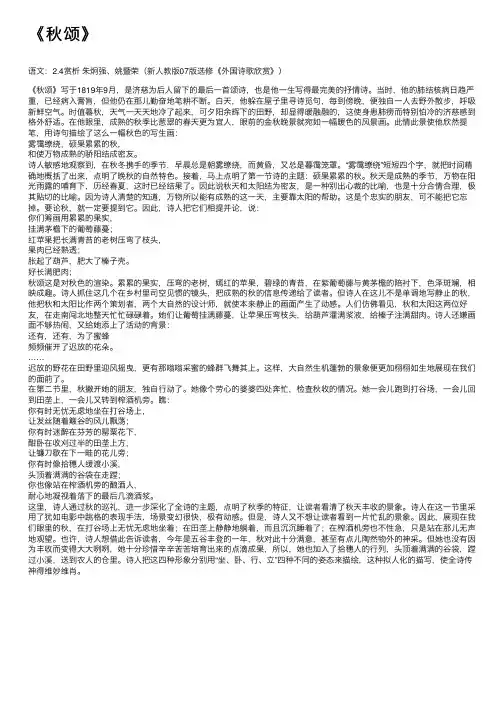
《秋颂》语⽂:2.4赏析朱炯强、姚暨荣(新⼈教版07版选修《外国诗歌欣赏》)《秋颂》写于1819年9⽉,是济慈为后⼈留下的最后⼀⾸颂诗,也是他⼀⽣写得最完美的抒情诗。
当时,他的肺结核病⽇趋严重,已经病⼊膏肓,但他仍在那⼉勤奋地笔耕不断。
⽩天,他躲在屋⼦⾥寻诗觅句,每到傍晚,便独⾃⼀⼈去野外散步,呼吸新鲜空⽓。
时值暮秋,天⽓⼀天天地冷了起来,可⼣阳余辉下的⽥野,却显得暖融融的,这使⾝患肺痨⽽特别怕冷的济慈感到格外舒适。
在他眼⾥,成熟的秋季⽐葱翠的春天更为宜⼈,眼前的⾦秋晚景就宛如⼀幅暖⾊的风景画。
此情此景使他欣然提笔,⽤诗句描绘了这么⼀幅秋⾊的写⽣画:雾霭缭绕,硕果累累的秋,和使万物成熟的骄阳结成密友。
诗⼈敏感地观察到,在秋冬携⼿的季节,早晨总是朝雾缭绕,⽽黄昏,⼜总是暮霭笼罩。
“雾霭缭绕”短短四个字,就把时间精确地概括了出来,点明了晚秋的⾃然特⾊。
接着,马上点明了第⼀节诗的主题:硕果累累的秋。
秋天是成熟的季节,万物在阳光⾬露的哺育下,历经春夏,这时已经结果了。
因此说秋天和太阳结为密友,是⼀种别出⼼裁的⽐喻,也是⼗分合情合理,极其贴切的⽐喻。
因为诗⼈清楚的知道,万物所以能有成熟的这⼀天,主要靠太阳的帮助。
这是个忠实的朋友,可不能把它忘掉。
要论秋,就⼀定要提到它。
因此,诗⼈把它们相提并论,说:你们筹画⽤累累的果实,挂满茅檐下的葡萄藤蔓;红苹果把长满青苔的⽼树压弯了枝头,果⾁已经熟透;胀起了葫芦,肥⼤了榛⼦壳。
好长满肥⾁;秋颂这是对秋⾊的渲染。
累累的果实,压弯的⽼树,嫣红的苹果,碧绿的青苔,在紫葡萄藤与黄茅檐的陪衬下,⾊泽斑斓,相映成趣。
诗⼈抓住这⼏个在乡村⾥司空见惯的镜头,把成熟的秋的信息传递给了读者。
但诗⼈在这⼉不是单调地写静⽌的秋,他把秋和太阳⽐作两个策划者,两个⼤⾃然的设计师,就使本来静⽌的画⾯产⽣了动感。
⼈们仿佛看见,秋和太阳这两位好友,在⾛南闯北地整天忙忙碌碌着。
她们让葡萄挂满藤蔓,让苹果压弯枝头,给葫芦灌满浆液,给榛⼦注满甜⾁。

济慈秋颂中英文对照济慈秋颂中英文对照济慈,英国浪漫主义诗人之一,于19世纪初期创作了许多脍炙人口的诗作。
其中《秋颂》一诗以其优美的文字和深邃的意境广受赞誉。
下面是这首诗的中英文对照,让我们一同领略济慈的才华吧。
一、中文版:季秋姑苏萧寺游,法象孪生复弁游。
神骨栖栖春院暖,月帏拂拂夏云收。
秋深不得星星寝,月晓更看名利休。
北斋苦画眉飞雪,主人甘面景精优。
千峰一个万壑引,江流成玉证神休。
云山犹合守千载,但将振落亥云浮。
二、英文版:A Song about AutumnIn autumn, I travel to the Xiao Temple in Su.I admire the dancing statue, which is alive and vivid.The divine bones rest in the warm spring;The moonlight gently sweeps away the summer clouds.As autumn deepens, the stars cannot get enough rest;In the moonlit dawn, I see the emptiness of fame and gain.My friend, the painter, struggles to capture the flying snow on the eyebrow,While the host enjoys the refined scenery with ease. Thousands of peaks converge into one, creating countless valleys, The river flows like jade, proving the existence of gods.The mountains and clouds have endured for a thousand years, But they will eventually crumble in the changing world.。
秋颂-《秋颂》语文:《秋颂》赏析朱炯强、姚暨荣《秋颂》写于1819年9月,是济慈为后人留下的最后一首颂诗,也是他一生写得最完美的抒情诗。
当时,他的肺结核病日趋严重,已经病入膏肓,但他仍在那儿勤奋地笔耕不断。
白天,他躲在屋子里寻诗觅句,每到傍晚,便独自一人去野外散步,呼吸新鲜空气。
时值暮秋,天气一天天地冷了起来,可夕阳余辉下的田野,却显得暖融融的,这使身患肺痨而特别怕冷的济慈感到格外舒适。
在他眼里,成熟的秋季比葱翠的春天更为宜人,眼前的金秋晚景就宛如一幅暖色的风景画。
此情此景使他欣然提笔,用诗句描绘了这么一幅秋色的写生画:雾霭缭绕,硕果累累的秋,和使万物成熟的骄阳结成密友。
诗人敏感地观察到,在秋冬携手的季节,早晨总是朝雾缭绕,而黄昏,又总是暮霭笼罩。
“雾霭缭绕”短短四个字,就把时间精确地概括了出来,点明了晚秋的自然特色。
接着,马上点明了第一节诗的主题:硕果累累的秋。
秋天是成熟的季节,万物在阳光雨露的哺育下,历经春夏,这时已经结果了。
因此说秋天和太阳结为密友,是一种别出心裁的比喻,也是十分合情合理,极其贴切的比喻。
因为诗人清楚的知道,万物所以能有成熟的这一天,主要靠太阳的帮助。
这是个忠实的朋友,可不能把它忘掉。
要论秋,就一定要提到它。
因此,诗人把它们相提并论,说:你们筹画用累累的果实,挂满茅檐下的葡萄藤蔓;红苹果把长满青苔的老树压弯了枝头,果肉已经熟透;胀起了葫芦,肥大了榛子壳。
好长满肥肉;秋颂这是对秋色的渲染。
累累的果实,压弯的老树,嫣红的苹果,碧绿的青苔,在紫葡萄藤与黄茅檐的陪衬下,色泽斑斓,相映成趣。
诗人抓住这几个在乡村里司空见惯的镜头,把成熟的秋的信息传递给了读者。
但诗人在这儿不是单调地写静止的秋,他把秋和太阳比作两个策划者,两个大自然的设计师,就使本来静止的画面产生了动感。
人们仿佛看见,秋和太阳这两位好友,在走南闯北地整天忙忙碌碌着。
她们让葡萄挂满藤蔓,让苹果压弯枝头,给葫芦灌满浆液,给榛子注满甜肉。
济慈《夜莺颂》是1818年济慈23岁的作品。
该诗歌一共八节80余行,该诗歌具有强烈的浪漫主义特色,用美丽的比喻和一泻千里的流利语言表达了诗人心中强烈的思想感情和对自由世界的深深向往。
Ode to a Nightingale 夜莺颂- John Keats 中英双语对照My heart aches, and a drowsy numbness pains 我的心痛,困顿和麻木My sense,as though of hemlock I had drunk,毒害了感官,犹如饮过毒鸩,Or emptied some dull opiate to the drains 又似刚把鸦片吞服,One minute past, and Lethe—wards had sunk 一分钟的时间,字句在忘川中沉没’Tis not through envy of thy happy lot,并不是在嫉妒你的幸运,But being too happy in thine happiness,——是为着你的幸运而大感快乐,That thou,light—winged Dryad of the trees 你,林间轻翅的精灵,In some melodious plot 在山毛榉绿影下的情结中,Of beechen green,and shadows numberless,Singest of summer in full-throated ease。
放开了歌喉,歌唱夏季。
O, for a draught of vintage!that hath been 哎,一口酒!那冷藏Cool’d a long age in the deep—delved earth,在地下多年的甘醇,Tasting of Flora and the country green,味如花神、绿土、Dance,and Provencal song,and sunburnt mirth!舞蹈、恋歌和灼热的欢乐!O for a beaker full of the warm South, 哎,满满一杯南方的温暖,Full of the true, the blushful Hippocrene, 充满了鲜红的灵感之泉,With beaded bubbles winking at the brim, 杯沿闪动着珍珠的泡沫,And purple-stained mouth 和唇边退去的紫色;That I might drink, and leave the world unseen,我要一饮以不见尘世,And with thee fade away into the forest dim 与你循入森林幽暗的深处Fade far away,dissolve,and quite forget 远远的离开,消失,彻底忘记What thou among the leaves hast never known, 林中的你从不知道的,The weariness,the fever, and the fret 疲惫、热病和急躁Here, where men sit and hear each other groan; 这里,人们坐下并听着彼此的呻吟;Where palsy shakes a few,sad,last gray hairs, 瘫痪摇动了一会儿,悲伤了,最后的几丝白发,Where youth grows pale, and spectre-thin,and dies; 青春苍白,古怪的消瘦下去,后来死亡;Where but to think is to be full of sorrowAnd leaden-eyed despairs, 铅色的眼睛绝望着;Where Beauty cannot keep her lustrous eyes, 美人守不住明眸,Or new Love pine at them beyond to—morrow. 新的恋情过不完明天.Away!away!for I will fly to thee,去吧!去吧!我要飞向你,Not charioted by Bacchus and his pards,不用酒神的车辗和他的随从,But on the viewless wings of Poesy, 乘着诗歌无形的翅膀,Though the dull brain perplexes and retards 尽管这混沌的头脑早已跟随你,Already with thee!tender is the night,夜色温柔,而月后And haply the Queen-Moon is on her throne, 正登上她的宝座,Cluster'd around by all her starry Fays; 周围是她所有的星星仙子,But here there is no light,但这处那处都没有光,Save what from heaven is with the breezes blown 一些天光被微风吹入幽绿,Through verdurous glooms and winding mossy ways. 和青苔的曲径。
秋颂(节选)罗兰曾有一位画家画过一幅霜染枫林的《秋院》。
高高的枫树,静静掩住一园幽寂,树后重门深掩,看不尽的寂寥,好像我曾生活其中,品尝过秋之清寂。
而我仍想悄悄步入画里,问讯那深掩的重门,看其中有多少灰尘,封存着多少生活的足迹。
最耐寻味是秋日天宇的闲云。
那么淡淡然、悠悠然,悄悄远离尘间,对俗世悲欢扰攘,不再有动于哀。
……秋是成熟的季节,是收获的季节,是充实的季节,却也是澹泊的季节。
它经了春之篷勃与夏之繁盛,不再以受赞美、被宠爱为荣。
它把一切的赞美与宠爱都隔离在澹澹的秋光外,而只愿做一个闲闲的、远远的、可望而不可即的,秋。
To Autumn (Expert)Luo LanThere was a painter who painted a frost-dyed “Autumn Yard ”which has the endless loneliness. The door is behind the high maple trees that covers the secluded garden. It seems that I lived in this place and tasted the Autumn of silence. I still want to go quietly into the painting, to look at the heavy door, to see how much dust and how may life footprints in it.The most intriguing is the cloud in sky of Autumn. It is not only lightly and leisurely, but also quietly away from the dust, the earthly sadness and trouble ...Autumn is the season of ripe, harvest, and repletion. But it is not seeking fame and gain. Autumn bears the spring and summer’s prosperity, no longer chasing praise and petting. It is isolated all the praise and petting out of its own light, and only willing to be the Autumn which is leisurely and chaste.。
济慈《秋颂》原文阅读
各位读友大家好,此文档由网络收集而来,欢迎您下载,谢谢
秋颂1雾气洋溢、果实圆熟的秋,你和成熟的太阳成为友伴;你们密谋用累累的珠球,缀满茅屋檐下的葡萄藤蔓;使屋前的老树背负着苹果,让熟味透进果实的心中,使葫芦胀大,鼓起了榛子壳,好塞进甜核;又为了蜜蜂一次一次开放过迟的花朵,使它们以为日子将永远暖和,因为夏季早填满它们的粘巢。
2谁不经常看见你伴着谷仓?在田野里也可以把你找到,弥有时随意坐在打麦场上,让发丝随着簸谷的风轻飘;有时候,为罂粟花香所沉迷,你倒卧在收割一半的田垄,让镰刀歇在下一畦的花旁;或者.像拾穗人越过小溪,你昂首背着谷袋,投下倒影,或者就在榨果架下坐几点钟,你耐心地瞧着徐徐滴下的酒浆。
秋颂3啊.春日的歌哪里去了?但不要
想这些吧,你也有你的音乐——当波状的云把将逝的一天映照,以胭红抹上残梗散碎的田野,这时啊,河柳下的一群小飞虫就同奏哀音,它们忽而飞高,忽而下落,随着微风的起灭;篱下的蟋蟀在歌唱,在园中红胸的知更鸟就群起呼哨;而群羊在山圈里高声默默咩叫;丛飞的燕子在天空呢喃不歇。
优美而迷人的诗篇,仿佛将“秋”像甘蔗一样的榨取甜汁,只留下甘美畅快的感觉。
秋在此时已化身仙女,轻抚你的额头,挥洒的全是芬芳。
秋颂这就是天才济慈。
今天哪里有人会写出这样的诗呢,他们说时代已经变迁,已无产生这样诗歌的土壤,其实不过是他们没有能力写出这样的诗歌罢了。
唉呀,何时能再有天才呢?
各位读友大家好,此文档由网络收集而来,欢迎您下载,谢谢。